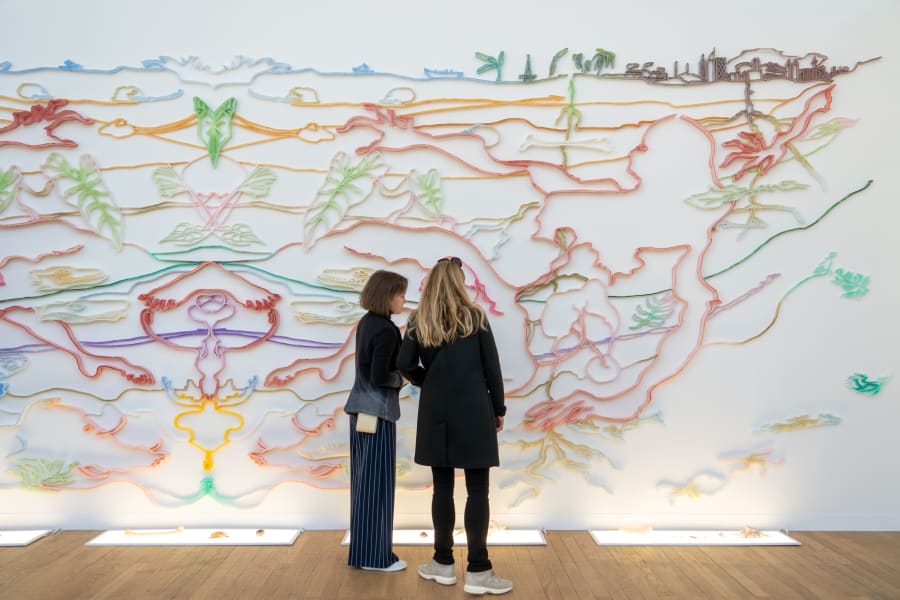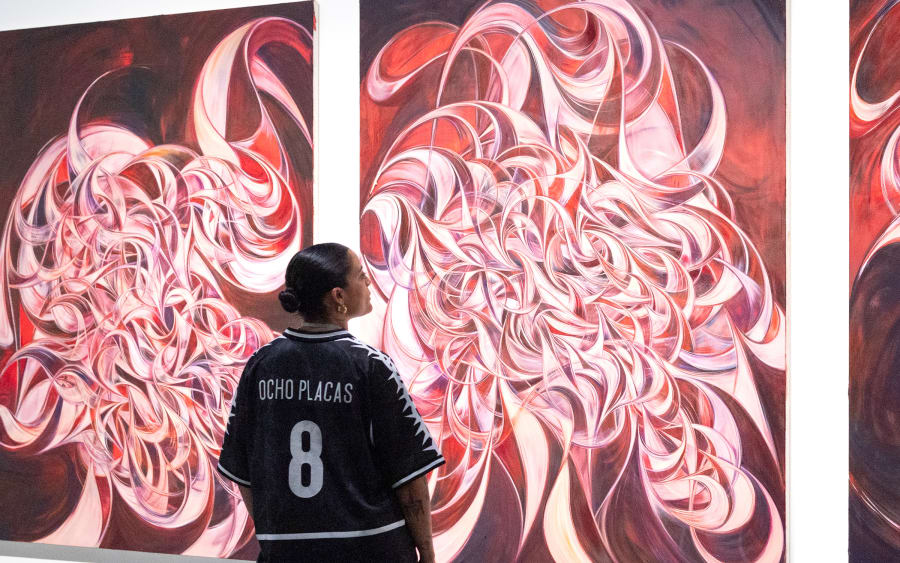The headline findings confirmed the trade’s lived experience – pitted against the distractions of contentious elections, geopolitical tensions and wars, and the direct impact of ongoing inflation, 2024 was tough for almost all sectors of the art market. Global sales declined by 12% to an estimated USD 57.5 billion – the second year that the market has slowed since an initially positive post-pandemic recovery in 2022.
Notably, the top end of the market dragged the rest down – the number of fine art works sold at auction for over USD 10 million fell by 39% in 2024, compounding a 27% drop in 2023. Sales in this top segment were also down by 45% by value, the biggest decline across all price brackets, and the USD 10 million-plus sector has gone from accounting for 33% of the art market’s total value in 2022, to just 18% in 2024. The total value of the top 50 lots sold at auction was also down a hair-raising 30% in 2024. Two years ago it was an entirely different story – pent-up post-pandemic supply and demand made the USD 10 million-plus sector the fastest growing in 2021 and 2022.
A dearth of supply is hobbling the top end. While most wealthy collectors are not materially worse off, global economic and political instability has contributed to an unease among would-be sellers who are consequently holding onto their art. According to the report’s author, the cultural economist Dr Clare McAndrew, many dealer respondents said that ‘divisive politics, wars, inflation, and other economic challenges had negative effects on sales and vendors’ plans, even if they were not directly impacted by them.’ Hesitancy, McAndrew says by phone, is crippling: ‘If you don’t have to sell something immediately and can hang on, why wouldn’t you? There’s that perception that it’s not an appropriate or right time to sell, and it affects the high-end auction sector most.’
A sobering read, but there are glimmers of light in the report. The lowest end of the market, for example, bucked the downward trend and although overall value was down in 2024, the number of items sold was up by 3% to 40.5 million, evidence that the industry is developing a much-needed broader base. ‘I think the positive thing was that sales were still ticking over, so the number of transactions were still high, but it was at the very low end – under USD 5,000,’ McAndrew says. At auction in 2024, a huge 95% of lots were sold for less than USD 50,000 (2% up on 2023), and the majority of those were sold for less than USD 5,000.
One reason for this uplift might be that, at this level, people are buying more for enjoyment than investment, McAndrew says. ‘There’s some evidence of new buyers in the market too, which is a really positive thing,’ she adds. ‘But also, as always with the art market, it’s [due to] what is available too.’
The sharp increase in online sales, hastened by the pandemic, also plays into this grassroots growth, as most transactions are at lower price points. Although the value of online sales dropped by 11% year-on-year in 2024 to USD 10.5 billion, that is still 76% above 2019 levels. Another area that countered the prevailing downward trend in 2024 was private sales at auction – up 14% by value year-on-year, contrasting with a 25% value drop in public auctions, testament to a desire to discreetly sell higher-value works rather than risk burning them on the open market.
So-called ‘ultra-contemporary’ art, defined in this report as being made by artists born from the 1970s onwards, is another casualty of a more cautious mindset. It is common in unstable times for buyers to flee to the tried and tested, to artists whose markets have weathered recessions and wars before. In a more optimistic 2021, an almost infinite supply of ultra-contemporary paintings was crucial in dragging a post-pandemic market out of the doldrums, with the value of sales of living artists’ work peaking at USD 4.3 billion, inflated by younger artists in particular, because optimism emboldens buyers – and flippers.
In unstable 2024, however, bankable postwar names and older living artists proved much more popular. Within the market for living artists, seven of the top 20 works sold in 2024, for instance, were by 87-year-old David Hockney. His painting A Lawn Being Sprinkled (1967) achieved the year’s second-highest price at auction for a work by a living artist, at USD 28.6 million at Christie’s New York. Ed Ruscha, also 87, had three works in the top 20 highest value. While works made in the previous 20 years accounted for 34% (USD 2.9 billion) of the postwar and contemporary auction market’s value in 2021, their values started to drop in 2023 and last year sales fell by 43%, to USD 1.1 billion, just over one third of its 2021 value.
For McAndrew, ‘a big worry’ is the plight of galleries who are coping with several years of rising inflation, a particular challenge for art dealers because, while their costs are escalating, their sales are slow moving and unpredictable. Although sales in 2020 plummeted, with no art fairs and their incumbent costs, most galleries dramatically reduced their outgoings to remain viable. Profitability remained relatively high in 2021, with still fewer events and leaner operations. But then inflation rocketed in 2022, continuing in 2023 and 2024, as fairs and the pressure to attend them restarted in earnest. The result? Last year, 43% of dealers were less profitable than in 2023 thanks to rising costs in almost every area, with the biggest ancillary spend being on art fairs (27%), packing and shipping (15%) and travel expenses (13%), all areas of highest inflation. Consequently, some galleries are cutting back on art fairs and 31 fairs ceased trading for various reasons in 2024.
Acknowledging the ‘current economic situation’, Art Basel chief executive Noah Horowitz says ‘it is more important than ever to be proactive, responsive and deeply attuned to the needs of our galleries’. He points to new initiatives including the Art Basel app and the launch of the Art Basel Awards, celebrating leading figures shaping the contemporary art world, which will enable the art fair ‘to bring new audiences into the fold’.
Horowitz adds: ‘At Art Basel, we remain unwavering in our mission to foster cultural exchange and support the vitality of the global art ecosystem. In an increasingly complex market landscape, we remain committed to working closely with our galleries to navigate challenges, amplify their voices, and help forge meaningful, future-facing connections with collectors and institutions worldwide.’
Dealers reported feeling cautiously optimistic at the close of Art Basel in Hong Kong in March after some concerns over consumer confidence leading up to the fair. According to the report, sales in China (including mainland China and Hong Kong) were also down by 31% as it fell into third place in terms of global sales by value (15%) behind the UK (with 18%, up by 1%) – the two have traded second and third place for years. While the Chinese market is slowing, its economy is still growing at a much faster pace than many other countries. But, McAndrew says, ‘I don’t think it’s going to be the engine for growth like it was coming out of the global financial crisis. It was really a huge boom in China that lifted us to that high 2014 level. Now, it’s behaving more like the US and the UK – the highs and lows are a little bit more subdued.’
The rise in protectionism and economic nationalism worldwide threatens to dismantle the globalization that has characterized the art market since the end of the last century. McAndrew writes in the report that this ‘may have more serious implications over the longer term.’ It should be noted that the report was written before US President Donald Trump’s ‘Liberation Day’ tariffs, announced on 2 April and intended to target some of the US's largest trading partners, which sent stock markets plunging. There is confusion over whether or not the tariffs apply to art, but ‘artworks’ – however they are defined – will be exempt, though it appears that antiques such as furniture and collectibles will be subject to tariffs. Those tariffs now appear to have been suspended for 90 days for every country apart from China. Either way, the confusion is damaging and may deter people from exporting to the US.
As McAndrew says, strong cross-border trade has been a defining feature of the art market in the past 20 to 30 years, and the ‘rise and dominance of contemporary art over the last decade has been due, in part, to the fact that there were very few restrictions on its movement across national borders [unlike much older art].’
McAndrew writes that the ‘global dominance of art hubs like the US and the UK is founded not only on their domestic wealth and art trade infrastructures but also on their transparent and regulated environments for art sales.’ Protectionist policies, meanwhile, are ‘directly detrimental to national art markets.’ Trump’s ‘very detrimental’ tariffs and protectionist policies might threaten the US’s hitherto unchallenged position as leader of the global art market, McAndrew thinks. While the US maintained its position as the leading art market worldwide, accounting for 43% of global sales by value, the value of sales in the US declined for a second year in 2024 (by 9% following a 10% decrease in 2023). This could potentially play into the hands of the London and Hong Kong art markets, so McAndrew will be watching the international auction houses keenly – where they choose to place major sales is a bellwether of where the market might head.
Download the 2025 Art Basel and UBS Art Market Report here.
Anna Brady, the former art market editor of The Art Newspaper, is a UK-based writer, editor and speaker. She was previously the features editor of Harper’s Bazaar Arabia and Harper’s Bazaar Art Arabia in Dubai, and diary editor at The Antiques Trade Gazette. Anna has been a regular guest on Monocle Radio and written for publications including Apollo, House & Garden, The World of Interiors, The Evening Standard, The Independent, The New European and Wallpaper.
Caption for top image : Visitors in front of works by Antonio Ballester Moreno, presented by Galeria Pedro Cera at Art Basel Hong Kong 2025.
Published on April 9, 2025.


